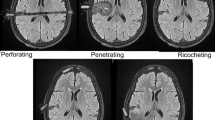Summary
Based on 9,000 craniocerebral traumas with 1,271 intracranial haematomas [Gießen General Surgery (n = 291) 1942–1974, Gießen Neurosurgery (n = 980) 1953–1974] distribution, diagnosis, therapy, and prognosis of traumatic haematoma has been discussed. Among 26 % of the haematomas, 6.4% were extradural, 17.2% were subdural, and 2.4% were intracerebral. Mortality has decreased from 84 % in the 1940's to 40 % in the last decades; the least decrease (64 %) being among the intracerebral haematomas. Distribution, site and size, symptomatology, and special diagnostic procedures were reported for the different types and forms of haematomas. Computertomography has proved to be the most decisive progress for the diagnosis, indication, timely and appropriate surgery, and follow up. The most important reasons for the still unfavourable results are lack of sufficient experience, among general surgeons and traumatologists, the lack of computer-tomographs, and the need for separate clinical and angiographic diagnosis.
Zusammenfassung
In einem Bericht über 9000 cranio-cerebrale Traumen mit 1271 traumatischen intrakraniellen Hämatomen [Chirurgie Gießen (n = 291) 1942–1974 und Neurochirurgie Gießen (n = 980) 1953–1974] wird zur Verteilung, Diagnose, Therapie und Prognose der Hämatome Stellung genommen. Unter 26 % Hämatomen lagen 6,4 %. extradural, 17,2 % subdural und 2,4 % intracerebral. Die Mortalität ist von 84 % in den 40er Jahren auf ca. 40% im letzten Jahrzehnt zurückgegangen, am geringsten mit 64 % bei den intracerebralen Hämatomen. Die einzelnen Blutungsformen werden hinsichtlich Lokalisation, Klinik und Behandlung besprochen. Die Computer-Tomographie hat die Diagnose perfektioniert und gewährleistet Indikation, zeitgerechte Operation und Verlaufskontrolle. Ihr Fehlen in den meisten chirurgi-schen und traumatologischen Abteilungen, damit der weiterhin notwendige Einsatz der Angiographie und die mangelnde Ausbildung in der Neurotraumatologie sind die wesentlichen Gründe für die immer noch ungünstige Prognose.
Similar content being viewed by others
Literatur
Frowein, R. A., Karimi-Nejad, A., Hamel, E.: Traumatic intracerebral haematomas. In: Spontaneous intracerebral haematomas. Edit.: Pia, H. W., Langmaid, C., Zierski, J. Berlin, Heidelberg, New York: Springer 1980
Haddad, F. S.: Nature and management of penetrating head injuries during the civil war in Lebanon. Can. J. Surg.21, 233–240 (1978)
Hagan, R. E.: Early complications following penetrating wounds of the brain. J. Neurosurg.34, 132–141 (1971)
Hammon, W. M.: Analysis of 2,187 consecutive penetrating wounds of the brain from Vietnam. J. Neurosurg.34, 127–131 (1971)
Jamieson, K. G., Yelland, J. D. N.: Extradural haematoma. J. Neurosurg.29, 13–23 (1968)
Jamieson, K. G., Yelland, J. D. N.: Surgically treated traumatic subdural hematomas. J. Neurosurg.37, 137–149 (1972)
Lanksch, W., Grumme, Th., Kazner, E.: Schädelhirnverletzungen im Computer-Tomogramm. Berlin, Heidelberg, New York: Springer 1978
Lanz, R.: Chirurgie unter Katastrophenbedingungen. In: Chirurgie der Gegenwart, Bd. 4a. Hrsg.: Zenker, R., Denker, F., Schink, W. München, Wien, Baltimore: Urban & Schwarzenberg 1976
Loew, F., Wüstner, S.: Diagnose, Behandlung und Prognose der traumatischen Haematome des Schädelinnern. Wien: Springer 1960
Neurological surgery of trauma. Edit.: Coats, J. B., Meirowsky, A. M. Office of the Surgeon General, Department of the Army, Washington DC, 1965
Parkinson, D., Newry, E. G., Taylor, J.: Traumatic intracerebral haematomas. In; Spontaneous intracerebral haematomas. Edit.: Pia, H. W., Langmaid, C., Zierski, J. Berlin, Heidelberg, New York: Springer 1980
Pia, H. W.: Indikation zu chirurgischem Eingreifen bei Schädel-Hirn-Verletzungen unter besonderer Berücksichtigung der Verkehrsunfälle. Langenbecks Arch. Klin. Chir.279, 178- 180 (1954)
Pia, H. W.: Klinik und Behandlung der schweren gedeckten Hirnverletzungen. Langenbecks Arch. Klin. Chir.280, 623–634 (1955)
Pia, H. W.: Therapeutische Maßnahmen bei gedeckten Schädel-Hirn-Verletzungen. Chirurg27, 415–420 (1956)
Pia, H. W.: Die Bewußtseinsstörungen bei Hirnverletzungen. Langenbecks Arch. Klin. Chir.281, 652–661 (1956)
Pia, H. W.: Fehler und Gefahren bei der Diagnose und Behandlung gedeckter Hirnverletzungen. Langenbecks Arch. Klin. Chir.298, 110–120 (1961)
Pia, H. W.: Schädel und Hirn. In: Chirurgie der frischen Verletzung, S. 1. Hrsg.: Börger, G. Stuttgart: Thieme 1978
Pia, H. W.: Offene Schädel-Hirn-Verletzungen. H. Unfallheilkd.138, 29–39 (1979)
Pia, H. W.: Schädel-Hirn-Verletzungen Langenbecks Arch. Chir. [Kongreßber.]349, 247–252 (1979)
Pia, H. W., Abtahi, H., Schönmayr, R.: Epidemiology, classifications and prognosis of severe craniocerebral injuries: computer-assisted study of 9,038 cases, p.31. (Advances in Neurosurgery, Vol. 3.) Berlin, Heidelberg, New York: Springer 1978
Tönnis, W.: Schußverletzungen des Gehirns. Zentralbl. Neurochir.6, 113–161 (1941)
Tönnis, W.: Grundsätzliche Bemerkungen zur operativen Wundbehandlung bei Hirnschüssen. Zentralbl. Neurochir.8, 1–5 (1943)
Tönnis, W.: Richtlinien für die Behandlung der Schußverletzungen des Gehirns und die Beurteilung ihrer Folgezustände. München: J. F. Lehmanns 1942
Tönnis, W., Seifert, E., Riechert, T.: Kopfverletzungen. Taschenbücher des Truppenarztes, Bd. lt. München, Berlin: J. F. Lehmanns 1938; 2. Aufl. 1943
Tönnis, W., Frowein, R. A., Loew, F., et al.: Organisation der Behandlung schwerer SchädelHirnverletzungen. (Arbeit und Gesundheit, Neue Folge, H. 79.) Stuttgart: Thieme 1968
Versorgung von Schädel-Hirn-Verletzungen Wiss. Beirat Bundesärztekammer (H. W. Pia). Dtsch. Ärztebl.67, 1224–1233 (1970)
Author information
Authors and Affiliations
Rights and permissions
About this article
Cite this article
Pia, H.W., Schönmayr, R. Traumatische intrakranielle Hämatome. Langenbecks Arch Chiv 351, 199–214 (1980). https://doi.org/10.1007/BF01262712
Received:
Issue Date:
DOI: https://doi.org/10.1007/BF01262712




